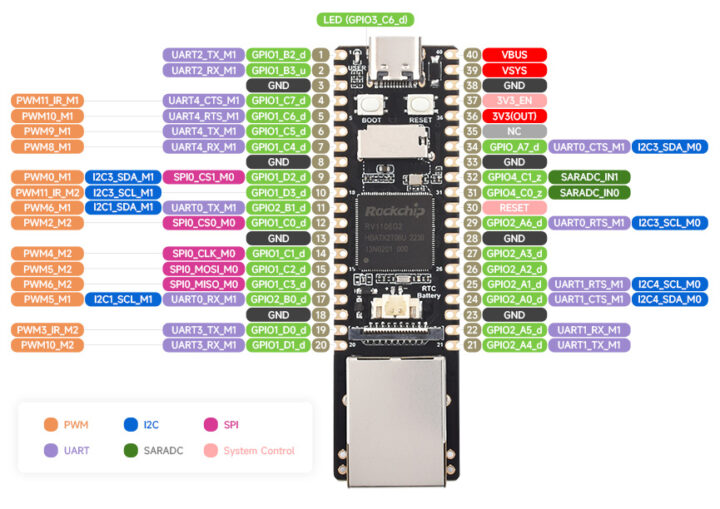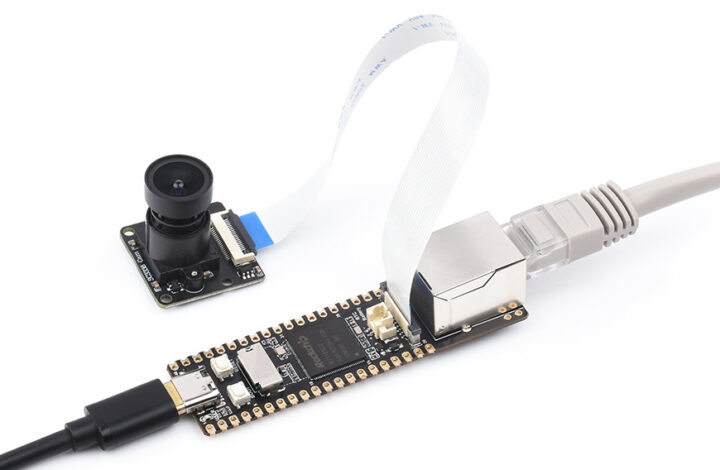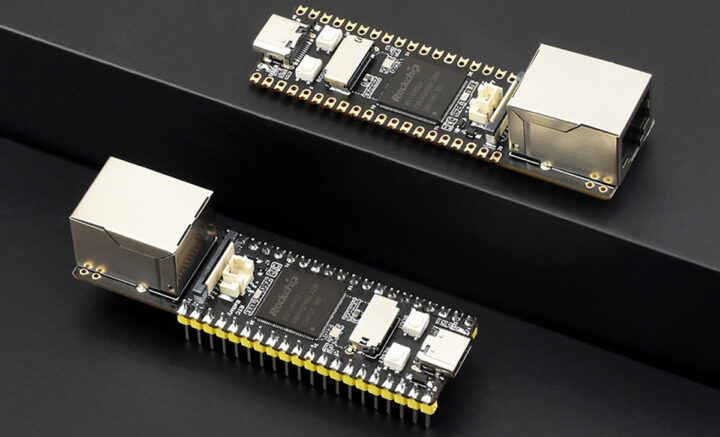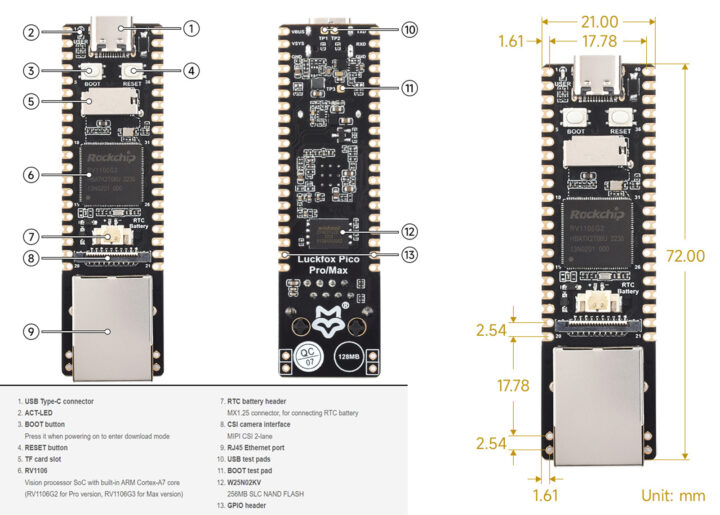The LuckFox LuckFox Pico Pro and Pico Max are two new Rockchip RV1106-powered development boards that offer a Linux-based development platform for IoT applications. The boards feature 10/100M Ethernet, up to 256MB DDR2 memory, and a 0.5TOPS NPU for AI tasks. With support for Buildroot and Ubuntu 22.04, this board can be used for smart homes, remote monitoring, and other AI-enhanced projects.
Last year, we covered the LuckFox Core3566, a Raspberry Pi Compute Module 4 alternative, and the LuckFox Pico with its RV1103 SoC which has a similar form factor and similar features to these new modules. But the new modules are built around the RV1106 SoC which features an Arm Cortex-A7 processor (up to 1.2GHz), a RISC-V co-processor, a 0.5 TOPS NPU for AI tasks, and a 4M @ 30fps ISP for high-quality image processing.
LuckFox Pico Pro and Pico Max Specifications
- SoC – Rockchip RV1106G2
- CPU – Arm Cortex A7 @ 1.2GHz with an integrated RISC-V co-processor.
- NPU– 0.5 TOPS, supports INT4/INT8/INT16, TensorFlow/MXNet/PyTorch/Caffe/Onnx NN
- ISP – 5MP high-performance, HDR, WDR, 3DNR, 2DNR, sharpening, defogging, fisheye and gamma correction, feature detection
- VPU – 3072×1728 (5M) @ 30fps H.265/H.264 encoding, 16M @ 60FPS JPEG snapshot
- System Memory
- LuckFox Pico Pro – 128MB DDR2
- LuckFox Pico Max – 256MB DDR2
- Storage – 256MB SPI NAND flash, microSD card slot
- Connectivity – 10/100M Ethernet RJ45 port
- Camera Interface – MIPI CSI 2-lane support for camera modules.
- Default camera specifications
- Type – Color Camera
- Image Sensor– SC3336
- CMOS Size– 1/2.8″
- Resolution– 3 MP (2304×1296)
- Aperture – F2.0
- Field of View – 98.3°
- Focal Length – 3.95mm
- Distortion – < 33%
- Max Frame Rate – 2304×1296 @ 30fps
- Focus Mode – Manual focus
- USB – USB 2.0 Host/Device Type-C port
- GPIO – 2x 20-pin headers with 26x GPIO pins
- Misc – ACT-LED; BOOT and RESET buttons
- Power Supply – 5V via USB-C port
- Dimensions – 72 x 21 mm
LuckFox provides two versions of their device: the Pico Pro, equipped with 128MB DDR2 memory, and the Pico Max, which comes with 256MB of memory. Both models feature 256MB of SPI NAND flash for storage.

The board offers various interfaces such as MIPI CSI, up to 26 GPIOs, UART, SPI, I2C, and USB. It also includes a 10/100M Ethernet controller with MAC PHY, a MicroSD card slot, a USB Type-C connector, and a 2-lane MIPI CSI camera interface.
The company says that the LuckFox Pico Pro and Pico Max module supports the SC3336 3MP Camera, featuring a SmartSens SC3336 sensor. This 3M MIPI CSI module is said to deliver “superior low-light capabilities, thanks to its high sensitivity and excellent signal-to-noise ratio”. We have also seen this camera used in the Firefly CT36L AI Smart Camera which we wrote about just last month.
In terms of software, LuckFox Pico Pro and Pico Max support Buildroot and Ubuntu 22.04 (server), and you’ll find the instructions to get started on the Wiki.
The Luckfox Pico Pro and Pico Max can be purchased on Aliexpress starting at $12.71 and on Amazon for $22.90 (Pico Max only) The SC3336 3MP camera module can be purchased separately on Aliexpress or Amazon for about $10 and up.
Debashis Das is a technical content writer and embedded engineer with over five years of experience in the industry. With expertise in Embedded C, PCB Design, and SEO optimization, he effectively blends difficult technical topics with clear communication
Support CNX Software! Donate via cryptocurrencies, become a Patron on Patreon, or purchase goods on Amazon or Aliexpress. We also use affiliate links in articles to earn commissions if you make a purchase after clicking on those links.







Nice finding! That made me discover the “LuckFox Pico Mini Linux RV1103” that’s even cheaper and smaller, basically the size of an attiny85 board (no net though), and the RV1103-based LuckFox Pico that is of the same size as the one above, but with RISC-V, ethernet, 512 MB DDR2 and a confusion between 1Gb and 1GB SDNAND.
There’s just a lot of confusion due to vendors copying each other, with boards based on chips with very close references (RV1106 for Cortex A7, RV1103 for the RISC-V one), bits vs bytes, “luckfox” vs “lucktorch”, not to mention even those that let you choose between models “A/B/C/D” without any single indication of which one is which… Oh well, I guess one needs to randomly buy based on first guess and see what arrives :-/
yeah just opened my received package today – bought a MangoPI risc-v MPi-GW1 and got a m28k (arm rk3528 – no upstream support though)
another funny thing is that some of the vendors are linking @cnx-software’s articles in the description 🙂 https://www.aliexpress.com/item/1005005849330610.html
Armbian has a pull request for the MangoPi M28K board at https://forum.armbian.com/topic/33024-armbian-build-pr-add-mangopi-m28k-board/
I found that but it’s based on rk-kernel (5.10-fork) 🙁
512Mb not MB, right? So 64MB.
I’ve been looking at these boards for a few months and I can’t find a reason to use them over the mikly-V duo–which have better software support.
I have more confidence in Rockchip to produce this SKU for a long time than a new entrant (SOPHGO/CVITEK?). Not that we can guess the future.
I agree, but I like the format of the tiny boards. I should have received my sophgo one today, I’ll check my mailbox. I don’t have big hopes, but who knows…
For some use cases I like the tiny form factor. One use case I’m having in mind is a power delivery controller, controlled over HTTP+ethernet. Small boards can be nice when they save PCB area. Another use case I’m having in mind (the same I envisionned for the breadbee) was to make some give-away haproxy load balancer for students. We’ve done that in the past using glinet products and it met a great success. When you’re learning load balancing and high availability, you need to be able to pull cables, not just click “off” in a VM. Such tiny devices are fun and inexpensive, and well suited to such use cases.
The main difference is that 1106 has the NPU and the 1103 doesn’t. The SDK for these chips is very good since Rockchip has a common SDK across all of their chips. Some parts of it are even in mainline. Besides, these chips are older, the SDK has been out for years. The most recent chip in this line is the RV1109.
Thank you Jon for the details. That indeed sounds appealing.
I forgot about the RV1126 another entry in the same product line with even more power. https://www.rock-chips.com/a/cn/product/RV11xilie/2020/0427/1075.html
2TOPS NPU and 4K encode/decode
When using the SDK the API makes these chips are all pretty much software compatible. That allows the same customer app to be used over a wide range of camera resolutions.
Even better, the same API is used for the RK3399 and the RK3588 so you can develop on those boards and then port onto the camera chips at the end of the process. It is not perfectly compatible, but it is close enough. It is much easier to do development on these larger chips with 1GB+ of RAM. The RK3588 has an NPU. You need the RK3399PRO to get the NPU.
These NPUs are not very powerful, they can do complex processing but it will take forever. It is better to think of them as a filter function. The local NPU would use it’s AI to alert the larger system recording the camera to start analyzing the video.
Wrt the SDK: LuckFox is at 5.10.110 as such they ‘skipped’ RK’s 5.10.160 and latest 6.1 BSP release.
(just kidding: they skipped nothing, just assembled what they got once it worked and never touched it again 🙂 )
With these tiny vendors I know from the start I’m the person who will be updating the SDK, not them. But their hardware is almost always a vanilla implementation of the reference design so that is typically a fairly easy process.
The bigger problem I have is getting access to the SDK releases. Chip vendors are so STUPID about that! Just put them up on github and save the expense of making me talk to a dozen people.